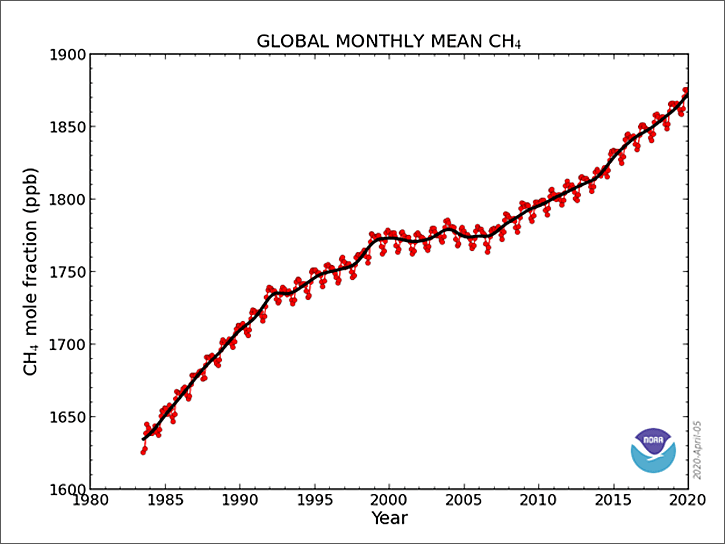(page 67 in Moving to Higher Ground, © John Englander, 2021)
Methane is a powerful greenhouse gas that is extremely effective at heating the atmosphere. In its pure form, at the molecular level, methane (CH4.) is over 100 times more potent than CO2 as a greenhouse gas, or atmospheric warming agent. Averaged over 20 years from its release in the atmosphere, methane has 86 times more heat-trapping ability than carbon dioxide. Methane is relatively unstable. Over the course of decades it breaks down in the atmosphere, ultimately transforming to CO2, which is extremely stable and has a lasting effect on global temperature for thousands of years. Averaged over 100 years, methane is 34 times more powerful than carbon dioxide in terms of warming, on a unit for unit basis.[1]
Methane has been responsible for extreme, rapid warming in the geologic past. Roughly 55 million years ago, a dramatic event, known as the Paleogene-Eogene Thermal Maximum, occurred when a huge amount of undersea methane was released into the atmosphere. Scientists sometimes refer to it as the “methane mega-fart.”[2] There is debate over what caused this gigantic release of methane, but it triggered sudden global warming and a subsequent mass extinction event.[3] In less than 20,000 years, the average global temperature rose about 11 degrees F (six degrees C). That huge change even made the Arctic rather balmy, with ocean temperatures as warm as 50 to 60 degrees F (10-20 degrees C).[4]
Atmospheric methane levels have surged by more than 30 percent over the last decade and currently account for about 16 percent of all greenhouse gas emissions. This rapid increase has created serious cause for concern.
The four major sources of methane emissions include:
- Hydraulic fracturing. Escaped methane from the “fracking” process to develop natural gas wells, as well as the transport and handling of the product. Methane from fracking has been rapidly increasing due to the boom in natural gas production and use in the U.S. and internationally. Recent research shows the volume of methane from fracking is much larger than previously believed. https://www.ccacoalition.org/en/resources/global-methane-assessment-full-report
- Agriculture, particularly cows. Best estimates suggest that the elimination of eating meat on a global scale could reduce greenhouse gases by about 17 percent.
- Permafrost thaw. The rapidly thawing Arctic tundra releases a tremendous quantity of methane in Alaska, Canada, Scandinavia, and Russia. In areas of Siberia, methane eruptions have created huge craters, which seem similar to the giant releases of methane tens of millions of years ago that likely caused rapid warming.
- Hydrates (or clathrates): This frozen, slushy type of ice under the seabed is essentially pure methane and believed to be the largest potential quantity on the planet. In fact, it is estimated that there is more of this form of methane than there is petroleum in the world. As the ocean warms, this methane will be released. Several scientific ships working in the far north off Siberia have reported massive areas of ocean that look like a carbonated beverage with endless tiny bubbles of methane venting from the seabed. Japanese researchers are actively testing the potential to access this frozen methane as an energy source.
In 2021, methane levels reached a record high at 1,893 ppb (parts per billion).[5] This increase coincides with the escalation of oil and gas drilling that began in 2006, with more than half directly attributable to shale fracking operations.[6] Figure 17 shows methane levels since 1983 with a spike starting in 2006. The current rate of increase is 27 times faster than during the methane mega-fart that caused the last mass extinction event.[7]

Figure 17: Global monthly mean concentration of methane in the atmosphere (Global Monitoring Lab, Earth System Research Laboratories, NOAA) https://www.esrl.noaa.gov/gmd/ccgg/trends_ch4/ .
Adding to the complexity and confusion is that natural gas is generally viewed as positive for climate change, under the theory that it is a much better alternative to energy sources like coal. That theory presumes that natural gas is completely burned. In the process of developing more natural gas production, a great deal of methane leaks into the atmosphere, increasing the warming.
The prospect of this massive methane release should spur us to reduce the emission of all greenhouse gases within our control as the highest possible priority as a way to slow the warming. Research about the methane in the seabed and permafrost should continue, though I believe it is unrealistic to expect that there will be any way for us to control those sources that are widely dispersed over millions of square miles and that are being released as a result of the warming and thawing.
For the latest measurements of methane and more information, see:
https://www.esrl.noaa.gov/gmd/ccgg/trends_ch4/
[1] T.F. Stocker et al., eds., “Climate Change 2013: The Physical Science Basis. Contribution of Working Group I to the Fifth Assessment Report of the Intergovernmental Panel on Climate Change”, IPCC (Cambridge, United Kingdom and New York, NY, USA: Cambridge University Press, 2013), Table 8.7, doi:10.1017/CBO9781107415324.
[2] M. Ruhl et. al., “Atmospheric Carbon Injection Linked to End-Triassic Mass Extinction”, Science 333, no. 6041 (2011): 430-434.
[3] D.J. Thomas et. al., “Warming the fuel for the fire: Evidence for the thermal dissociation of methane hydrate during the Paleocene-Eocene thermal maximum”, Geology 30, no. 12 (2002): 1067-1070.
[4] C.J. Shellito et. al., “Climate model sensitivity to atmospheric CO2 levels in the Early-Middle Paleogene”, Palaeogeography, Palaeoclimatology, Palaeoecology 193, no.1 (2003): 113-123.
[5] Jeremy Deaton, “Methane Levels Reach an All-Time High”, Scientific American, April 12th, 2020, https://www.scientificamerican.com/article/methane-levels-reach-an-all-time-high/.
[6] Robert W. Howarth, “Ideas and perspectives: is shale gas a major driver of recent increase in global atmospheric methane?”, Biogeosciences 16, (August 14th, 2019): 3033-3046, https://doi.org/10.5194/bg-16-3033-2019.
[7] Ying Cui et. al., “Slow release of fossil carbon during the Palaeocene-Eocene Thermal Maximum”, Nature Geoscience, no. 4 (2011): 481-485, https://doi.org/10.1038/ngeo1179.